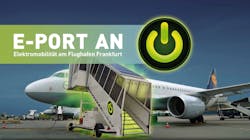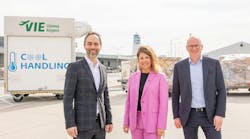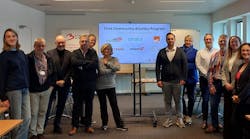Flying begins on the ground. That’s a great way of promoting the ground handling industry. Without the ground support equipment no suitcase would make it to the conveyor belt, no passenger would get to the plane and no plane would have a full tank before departure.
We’d very much like to take credit for it, but we found the phrase on the Fraport website while we researched E-Port, an effort undertaken in part by ground service provider Fraport at the Frankfurt Airport to cut down on emissions by using more electric ground support equipment.
Superlative such as “busiest airport” don’t quite do justice like the annual figures about ground handling at the airport:
- Two million tons of cargo.
- 58 million passengers.
- 100 airlines.
- 295 destinations.
Moving that much product and that many people requires a lot of ground support equipment. The ground service provider has certainly operated many type of electric ground support equipment
In 2012, however, the company made a more concerted effort to electrify its fleet with the plan to remove 500 tonnes of CO2 annually when compared to operating diesel equivalents.
Fraport identified several general areas to incorporate electric GSE:
Passenger stairs: Electric stairs allow passengers to enter and leave the airplanes of the Boeing 737 and Airbus A320 class, with the batteries being charged by solar panels on the roof. The reduction in Co2 and exhaust gases is obvious, but maybe greater than you may think. The reason: Due to the short distances, diesel engines previously used to run almost constantly. In cases of low solar radiation, the batteries can charged at regular stations. Even the lighting of the stairs utilizes very economical LEDs.
Cargo lifts: Heavy-lifting pallet forklifts ensure the food and baggage is able to board aircrafts, carrying loads of several tons at a time and consuming significant quantities of fuel. However, Fraport is now making use of zero emissions electric drive machines, able to stem loads of up to seven tons to a loading height between 1.90 meters and 2.60 meters with a speed of up to 15 km/h.
Aircraft towing: Maybe the largest source of wasted jet fuel is the traditional notion of taxiing an aircraft under its own power. While aircraft makers have made their new planes much more fuel-efficient that efficiency comes in the air on the tarmac. In turn, diesel-powered tractors can certainly do the job, but the 2,000-horsepower engine required to tow an aircraft also produce a fair share of CO2 emissions.
Hence, Fraport’s use of the TaxiBot, a piece of equipment we’ve written about before after being invited to France to witness it in action.
TaxiBot, a semi-robotic pilot-controlled vehicle, is designed to transport airplanes from airport gate to the runway and back, without using the airplane’s engines. Since 2009, Both TLD and IAI, in cooperation with Lufthansa LEOS, have been developing the TaxiBot, with the support of both OEMs Airbus and Boeing.
On a related note, The Boeing 737 is now officially certified for TaxiBot dispatch towing, by the European Aviation Safety Agency (EASA) and the Civil Aviation Authority of Israel (CAAI). The Supplement Type Certificate (STC) was issued for Boeing 737 Classic aircraft.
In addition, Kalmar Motor AB, the aircraft tractor specialist, is currently completing construction of the world’s first hybrid electric tractor designed specifically for wide body aircrafts. The TBL 800 ‘eSchlepper’ began testing last January with partner Lufthansa LEOS.
This hybrid tractor combines a lithium-ion battery system with a diesel engine. The TBL 800 has its own onboard charger, so it simply needs to be hooked up to an electric point in the tractor parking area or workshop. The diesel engine is used only for charging, to ensure that the battery never becomes fully discharged, and is expected to run for less than 30 percent of the time.
Ground transport for ground transport employees: Other electric vehicles in operation under the E-Port project include cars to ferry Fraport ground staff around the airport. A fleet of Mitsubishi i-MiEV(MiEV is an acronym for "Mitsubishi innovative Electric Vehicle") is a five-door hatchback electric car produced by Mitsubishi Motors. All the car needs to recharge is a cable with a standard 2-pin Europlug. Connected to a conventional 233 V socket, the battery can be fully charged in six hours.Fraport isn’t alone in its efforts. The E-Port program is a joint effort that also includes Lufthansa and the German government. Just last year, the E-Port project won a GreenTec Award, which is among the world's largest independent environmental and economic prices.-



